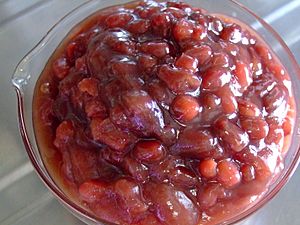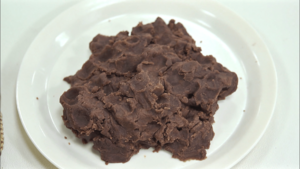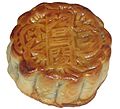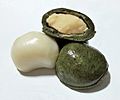Red bean paste facts for kids
 |
|
| Alternative names | Red bean jam, adzuki bean paste, anko |
|---|---|
| Type | Sweet paste |
| Region or state | East Asia |
| Main ingredients | Red beans, sugar or honey |
Red bean paste (traditional Chinese: 豆沙/紅豆沙; simplified Chinese: 豆沙/红豆沙; Japanese: 餡こ or 小豆餡; Korean: 팥소) or red bean jam, also called adzuki bean paste or anko (a Japanese word), is a paste made of red beans (also called "adzuki beans"), used in East Asian cuisine. The paste is prepared by boiling the beans, then mashing or grinding them. At this stage, the paste can be sweetened or left as it is. The color of the paste is usually dark red, which comes from the husk of the beans. In Korean cuisine, the adzuki beans (often the black variety) can also be husked prior to cooking, resulting in a white paste. It is also possible to remove the husk by sieving after cooking, but before sweetening, resulting in a red paste that is smoother and more homogeneous.
Etymology
| Regional names | |||||||||||||||
|---|---|---|---|---|---|---|---|---|---|---|---|---|---|---|---|
| Chinese name | |||||||||||||||
| Traditional Chinese | 豆沙 / 紅豆沙 | ||||||||||||||
| Simplified Chinese | 豆沙 / 红豆沙 | ||||||||||||||
| Literal meaning | "Bean paste" / "red bean paste" | ||||||||||||||
|
|||||||||||||||
| Korean name | |||||||||||||||
| Hangul | 팥소 | ||||||||||||||
| Literal meaning | "Red bean filling" | ||||||||||||||
|
|||||||||||||||
| Japanese name | |||||||||||||||
| Kanji | 餡 / 小豆餡 | ||||||||||||||
| Kana | あん / あずきあん | ||||||||||||||
|
|||||||||||||||
In Japanese, a number of names are used to refer to red bean paste; these include an (餡), anko (餡子) and ogura (小倉). Strictly speaking, the term an can refer to almost any sweet, edible, mashed paste, although without qualifiers red beans are assumed, while azukian (小豆餡) refers specifically to the paste made with red beans. Other common forms of an include shiroan (白餡, "white bean paste"), made from navy or other white beans, green beans and kurian (栗餡), made from chestnuts.
Similarly, the Chinese term dòushā (豆沙), applies to red bean paste when used without qualifiers, although hóngdòushā (Chinese: 紅豆沙) explicitly means "red bean paste."
In Korean, pat (팥, "V. angularis") contrasts with kong (콩, "bean"), rather than being considered a type of it. Kong ("beans") without qualifiers usually means soybeans. As so (소) means "filling", the word patso (팥소) means "pat filling", with unsweetened dark-red paste as its prototype. Dan (단, "sweet") attached to patso makes danpat-so (단팥소), the sweetened red bean paste, which is often called danpat (단팥; "sweet pat"). Geopi (거피, "hulled, skinned, peeled, shelled, etc.") attached to pat makes geopipat (거피팥), the dehulled red beans and the white paste made of geopipat is called geopipat-so (거피팥소).
Types
Red bean paste is graded according to its consistency, sweetness, and color.
Chinese
In Chinese cuisine, the most common types are:
Japanese
In Japanese cuisine and confectionery, the most common types are:
- Tsubuan (粒餡): Whole red beans are boiled with sugar but otherwise untreated
- Tsubushian (潰し餡): The beans are mashed after boiling
- Koshian (漉し餡): The beans are passed through a sieve to remove bean skins. This is the most common type
- Sarashian (晒し餡): The beans are dried and reconstituted with water
- Ogura-an (小倉餡): Is a mix of koshian and tsubuan.
Korean
In Korean cuisine and confectionery, the most common types are:
- Patso (팥소), dark-red paste made by boiling and then mashing or grinding red beans. The bean skins may or may not be removed by sifting the paste through a sieve to make the paste smoother.
- Danpat (단팥) or danpat-so (단팥소), sweetened red bean paste, made by adding honey or sugar when making patso. The bean skins are often removed to make the paste smoother.
- Geopipat-so (거피팥소), white paste made by boiling dehulled red beans, and then mashing or grinding them.
Uses
Chinese
Red bean paste is used in many Chinese dishes, such as:
- Red bean soup (紅豆湯/紅豆沙; pinyin: hóng dòu tāng / hóng dòu shā): In some recipes, red bean paste with more water added to form a tong sui, or thick, sweet soup. It is often cooked and eaten with tangyuan and lotus seeds. This is almost always a dessert.
- Tangyuan (湯圓, pinyin: tāng yúan): Glutinous rice balls filled with sweet fillings such as red bean paste and boiled in plain or sweetened water.
- Sweet zongzi (粽子; pinyin: zòng zi): Glutinous rice and red bean paste wrapped with bamboo leaves and steamed or boiled. The glutinous rice used to make zongzi is usually specially prepared and appears yellow.
- Mooncakes (月餅; yùe bĭng): A baked pastry consisting of thin dough surrounding a filling. The filling is traditionally made from various ingredients, including mashed lotus seeds, red bean paste, or other fillings. The texture of this filling is quite similar to straight red bean paste. It is most commonly eaten during the Mid-Autumn Festival.
- Bāozi (豆沙包; pinyin: dòu shā bāo): Steamed leavened bread filled with a variety of savoury or sweet fillings.
- Jiān dui (煎堆): Fried pastry made from glutinous rice flour, sometimes filled with red bean paste.
- Red bean cake (Chinese: 红豆糕; pinyin: hóng dòu gāo): It is a type of Asian cake with a sweet red bean paste filling. It is made primarily with adzuki beans.
- Red bean pancake
-
Chinese mooncake
Japanese
Red bean paste is used in many Japanese sweets.
- Anmitsu, a dessert consisting of red bean paste, small cubes of agar jelly, and pieces of fruit served with syrup.
- Anpan, a sweet bun filled with red bean paste.
- Daifuku, a confection consisting of a small round rice cake stuffed with red bean paste.
- Anko dango, a dumpling made from rice flour that is sometimes topped or filled with red bean paste.
- Dorayaki, a confection consisting of two small pancake-like patties made from castella wrapped around a filling of red bean paste.
- Imagawayaki, a paste is in the pancake. Also known as Ōban-yaki.
- Manjū, a steamed cake filled with red bean paste.
- Oshiruko or Zenzai, adzuki bean soup, commonly served with rice cake.
- Sakuramochi, a Japanese sweet consisting of sweet pink-colored rice cake (mochi) with a red bean paste (anko) center, and wrapped in a pickled cherry blossom (sakura) leaf.
- Taiyaki, a fish-shaped cake stuffed with red bean paste.
- Yōkan, a thick jellied dessert made of red bean paste, agar, and sugar.
Korean
Red bean paste is used in various Korean snack foods and desserts, including:
- Baram-tteok, a type of tteok filled with white geopipat-so.
- Bungeo-ppang, a fish-shaped pastry filled with sweet danpat-so.
- Chalbori-ppang, two small and sweet pancakes wrapping around sweet danpat-so.
- Chapssal doughnut, a glutinous rice doughnut filled with sweet danpat-so.
- Gyeongdan, a rice ball cake filled with sweet danpat-so.
- Hodu-gwaja, a walnut-shaped cookie filled with sweet danpat-so.
- Hoppang, a warm fluffy pastry filled with sweet danpat-so or sweet nokdu-so (mung bean paste).
- Hwangnam-ppang, a pastry with a chrysanthemum imprinted on the top, filled with sweet danpat-so.
- Jjinppang, a warm fluffy pastry filled with unsweetened patso, usually with the skins of the red beans.
- Kkulppang, a sweet pastry covered with sweet danpat-so and covered with corn syrup.
- Patbingsu, a type of shaved ice.
- Songpyeon, a type of tteok filled with various fillings including unsweetened patso, sweetened (danpat-so), or white (geopipat-so).
- Ttongppang, a poo-shaped pastry filled with sweet danpat-so.
-
Jjinppang filled with patso
-
Danpat-doneot filled with danpat-so
-
Hodu-gwaja filled with danpat-so
-
Baram-tteok filled with geopipat-so
See also
 In Spanish: Anko para niños
In Spanish: Anko para niños












